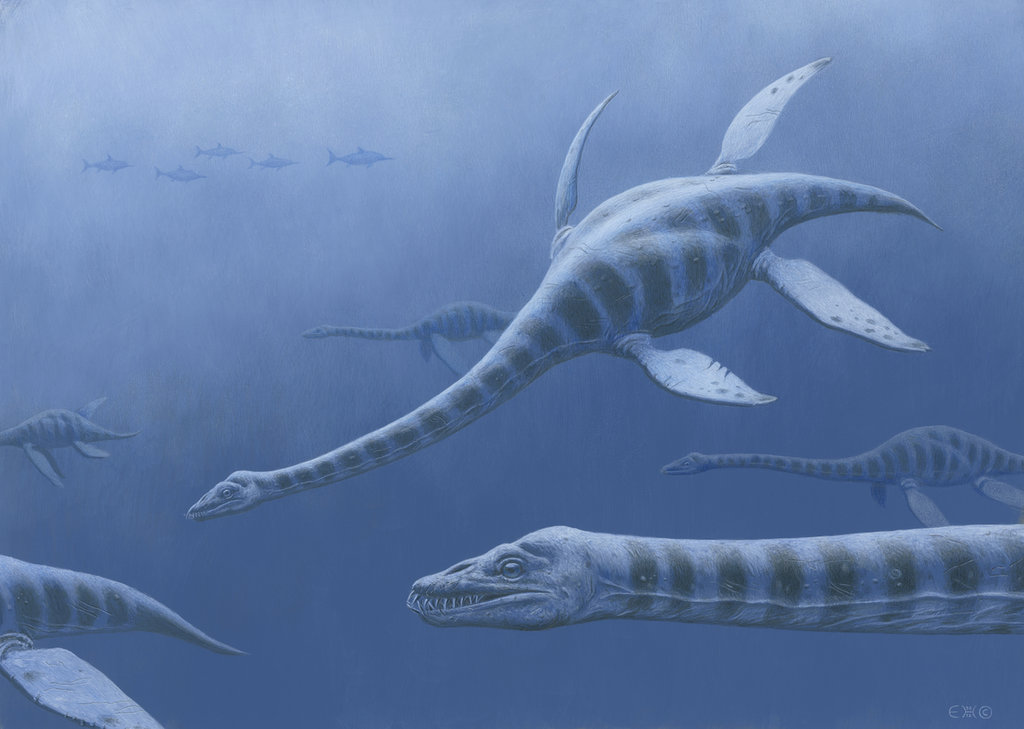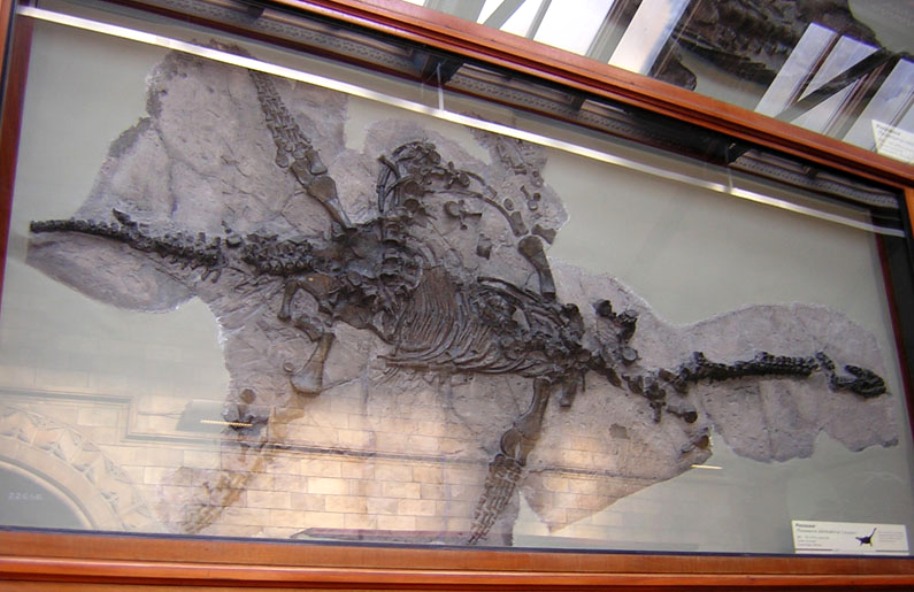

On this month's Oddities in the News Page:
The lastest hunt for the Loch Ness Monster will use DNA searches
IN THE ODDITIES ARCHIVES
Clone
Cereal
Donald Trump Look-Alike
A Real Killer Clown
New Dinosaur
Elisa Lam
Secret Room

Above is the most famous photo of "Nessie," taken in 1934 by a London Surgeon.

Above is an artist's conception of a Plesiosaurus

Here is a fossil of a real Plesiosaurus
DNA Survey of Life in Loch Ness Hunts for Its Monster Resident
The goal is to catalog the lake’s diversity of life—including any oversized, prehistoric reptiles
Hunt began in June 2018
May 29, 2018
If the Loch Ness monster exists—and it’s not some pan-dimensional creature from the fairy world—it should have DNA.
Like other creatures that lurk in watery realms, that DNA should be floating all over its lake home, Loch Ness, in Scotland. Scientists can use this genetic material, known as eDNA, to track elusive beasts. And now researchers are turning that powerful method on Loch Ness to create the most comprehensive biodiversity catalog of its residents yet, Reuters reports. And it may or may not include “Nessie.”
Almost every creature that touches a body of water leaves DNA-filled traces behind. Ducks may leave skin cells and feces, fish shed scales and urine, amphibians shed mucus, and even mammals like deer leave some saliva when they bend down to drink. And as the price for DNA testing has plummeted, comprehensive surveys of water bodies have become more feasible.
The Loch Ness researchers hope to create a similar catalogue while surveying the lake’s DNA. The researchers have been collecting samples since April, Michael Greshko writes for National Geographic and they began extracting information in June.
“While the prospect of looking for evidence of the Loch Ness monster is the hook to this project, there is an extraordinary amount of new knowledge that we will gain from the work about organisms that inhabit Loch Ness,” team leader Neil Gemmell of the University of Otago in New Zealand, says in a press release. The team expects to release their findings in January of 2019.
Gemmell is going into the work with an open mind. “I don’t believe in the idea of a monster,” Gemmell tells Martin Belam at The Guardian. “But I’m open to the idea that there are things yet to be discovered and not fully understood. Maybe there’s a biological explanation for some of the stories.” The DNA could support alternative explanations for Nessie sightings, including giant sturgeon or catfish.
Even if Nessie’s genetic fingerprint doesn’t show, the search will still be worthwhile. New species of bacteria may hide in the deep, dark loch. And the researchers hope to track the spread of invasive species.
“There’s been an awful lot of people taking an awful lot of gear into Loch Ness over the years,” Gemmell tells Alison Gilchrist at Scientific American. “There’s suggestions that there’s an invasive shrimp species from the southern United States in Loch Ness. There’s been reports recently of pink salmon, which is of course a Pacific salmon, in the Ness River.”
Overall, the chances of Nessie turning up are pretty slim. As History.com reports, stone carvings of the beast date back to 500 A.D., likely created by the Picts, a group of indigenous inhabitants of Scotland. But over the years, efforts to locate the beast have failed.
In 2003, the BBC funded a massive expedition using satellites and 600 sonar beams but didn’t find any signs of the beast. A marine drone that scoured the lake in 2016 also failed to turn up evidence of a monster. (But the probe did find a Nessie replica used in the 1970 film “The Private Life of Sherlock Holmes.”)
As Reuters reports, the most convincing bit of evidence is a 1934 image dubbed the “Surgeon’s Photo.” But six decades after it was taken, it was revealed to be a hoax.
See more HERE
A VERY OLD STORY
The first written story of the monster is in a text written in the year 565 AD by a Celtic biographer: this writer describes how a man was attacked by a monster while he was swimming in the river Ness. Perhaps the legend already existed in those days: it has certainly existed for many centuries in Scottish folklore.
However, the story of the monster was not very well-known in England for one simple reason: Loch Ness is a very long way from the rest of Britain. Until the age of the railway, very few people ever went to the Highlands of Scotland....except soldiers or officials from the cities of the Scottish Lowlands. No-one else had any reason to go there: the North of Scotland was wild anddesolate, wet and generally cold, and inhabited more by sheep than by people.
The myth became big news in 1930; three men, out in a boat on the lake, said that they had seen a monster. Immediately, several other people said that they had seen one too. In 1933, a man took the first "photo" of the monster, from a distance of about 100 metres. The photo was not clear, but Kodak said that the photo was real.
The most famous photo of all was taken in 1934 by a London surgeon; it seems to show a long neck and a small head sticking up out of the water. "Nessie" - if the photo is real - looks something like a dinosaur.
Or it could be someone's arm and hand.
See more HERE
THE SEARCH CONTINUES
Amateur investigators kept an almost constant vigil, and in the 1960s several British universities launched expeditions to Loch Ness, using sonar to search the deep. Nothing conclusive was found, but in each expedition the sonar operators detected large, moving underwater objects they could not explain.
In 1975, Boston’s Academy of Applied Science combined sonar and underwater photography in an expedition to Loch Ness. A photo resulted that, after enhancement, appeared to show the giant flipper of a plesiosaur-like creature. Further sonar expeditions in the 1980s and 1990s resulted in more tantalizing, if inconclusive, readings.
Revelations in 1994 that the famous 1934 photo was a hoax hardly dampened the enthusiasm of tourists and professional and amateur investigators to the legend of the Loch Ness Monster.
See more HEREWhat kind of dinosaur would Nessie be?
Plesiosaurus (Greek: πλησιος/plesios, near to + σαυρος/sauros, lizard) is a genus of extinct, large marine sauropterygian reptile that lived during the early part of the Jurassic Period, and is known by nearly complete skeletons from the Lias of England. It is distinguishable by its small head, long and slender neck, broad turtle-like body, a short tail, and two pairs of large, elongated paddles. It lends its name to the order Plesiosauria, of which it is an early, but fairly typical member. It contains only one species, the type, Plesiosaurus dolichodeirus.
See more HERE